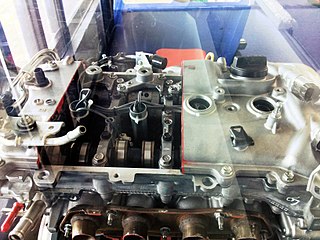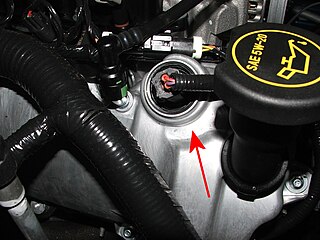Related Research Articles

A camshaft is a shaft that contains a row of pointed cams in order to convert rotational motion to reciprocating motion. Camshafts are used in piston engines, mechanically controlled ignition systems and early electric motor speed controllers.

A desmodromic valve is a reciprocating engine poppet valve that is positively closed by a cam and leverage system, rather than by a more conventional spring.

VTEC is a system developed by Honda to improve the volumetric efficiency of a four-stroke internal combustion engine, resulting in higher performance at high RPM, and lower fuel consumption at low RPM. The VTEC system uses two camshaft profiles and hydraulically selects between profiles. It was invented by Honda engineer Ikuo Kajitani. It is distinctly different from standard VVT systems which change only the valve timings and do not change the camshaft profile or valve lift in any way.

Variable valve timing (VVT) is the process of altering the timing of a valve lift event in an internal combustion engine, and is often used to improve performance, fuel economy or emissions. It is increasingly being used in combination with variable valve lift systems. There are many ways in which this can be achieved, ranging from mechanical devices to electro-hydraulic and camless systems. Increasingly strict emissions regulations are causing many automotive manufacturers to use VVT systems.

VVT-i, or Variable Valve Timing with intelligence, is an automobile variable valve timing petrol engine technology manufacturer by Toyota Group and used by brands Groupe PSA, Toyota, Lexus, Scion, Daihatsu, Subaru, Aston Martin, Pontiac and Lotus Cars. It was introduced in 1995 with the 2JZ-GE engine found in the JZS155 Toyota Crown and Crown Majesta.

MIVEC (Mitsubishi Innovative Valve timing Electronic Control system) is the brand name of a variable valve timing (VVT) engine technology developed by Mitsubishi Motors. MIVEC, as with other similar systems, varies the timing of the intake and exhaust camshafts which increases the power and torque output over a broad engine speed range while also being able to help spool a turbocharger more quickly and accurately.

Variable camshaft timing (VCT) is an automobile variable valve timing technology developed by Ford. It allows for more optimum engine performance, reduced emissions, and increased fuel efficiency compared to engines with fixed camshafts. It uses electronically controlled hydraulic valves that direct high pressure engine oil into the camshaft phaser cavity. These oil control solenoids are bolted into the cylinder heads towards the front of the engine near the camshaft phasers. The powertrain control module (PCM) transmits a signal to the solenoids to move a valve spool that regulates the flow of oil to the phaser cavity. The phaser cavity changes the valve timing by rotating the camshaft slightly from its initial orientation, which results in the camshaft timing being advanced. The PCM adjusts the camshaft timing depending on factors such as engine load and RPM.

An overhead valve (OHV) engine, sometimes called a pushrod engine, is a piston engine whose valves are located in the cylinder head above the combustion chamber. This contrasts with flathead engines, where the valves were located below the combustion chamber in the engine block.
The Hyundai Beta engines are 1.6 L to 2.0 L I4 built in Ulsan, South Korea.

The Valvetronic system is a BMW variable valve lift system which, in combination with VANOS, allows infinite adjustment of the intake valve timing and lift. The system claims to improve fuel economy and emissions, and negates the need for a throttle body in regular use.
A transmission control unit (TCU), also known as a transmission control module (TCM), or a gearbox control unit (GCU), is a type of automotive ECU that is used to control electronic automatic transmissions. Similar systems are used in conjunction with various semi-automatic transmissions, purely for clutch automation and actuation. A TCU in a modern automatic transmission generally uses sensors from the vehicle, as well as data provided by the engine control unit (ECU), to calculate how and when to change gears in the vehicle for optimum performance, fuel economy and shift quality.

A valvetrain is a mechanical system that controls the operation of the intake and exhaust valves in an internal combustion engine. The intake valves control the flow of air/fuel mixture into the combustion chamber, while the exhaust valves control the flow of spent exhaust gases out of the combustion chamber once combustion is completed.
Pneumatic valve springs are metal bellows filled with compressed air used as an alternative to the metal wire springs used to close valves in high-speed internal combustion engines. This system was introduced in Formula One in 1986 with the Renault EF-Type.

In a spark ignition internal combustion engine, ignition timing is the timing, relative to the current piston position and crankshaft angle, of the release of a spark in the combustion chamber near the end of the compression stroke.
A helical camshaft is a type of mechanical variable valve actuation (VVA) system. More specifically, it is a camshaft that allows the valve opening duration to be varied over a wide, continuous, step-less range, with all of the added duration being at full valve lift.

MultiAir or Multiair is a hydraulically-actuated variable valve timing (VVT) and variable valve lift (VVL) engine technology enabling "cylinder by cylinder, stroke by stroke" control of intake air directly via a gasoline engine's inlet valves. Developed by Fiat Powertrain Technologies, the technology addresses a primary engine inefficiency: pumping losses caused by restricting intake passage by the throttle plate that regulates air feeding the cylinders.

MAN B&W diesel and New Sulzer Diesel are developing “smart” camshaftless engines utilizing electronically controlled fuel injection and exhaust valve actuation systems. Research and development has advanced so that smart low-speed diesel engines are being installed in new ships.
Variable valve lift (VVL) is an automotive piston engine technology which varies the height a valve opens in order to improve performance, fuel economy or emissions. There are two main types of VVL: discrete, which employs fixed valve lift amounts, and continuous, which is able to vary the amount of lift. Continuous valve lift systems typically allow for the elimination of the throttle valve.
The Koenigsegg TFG is an inline-3 engine. The TFG stands for "Tiny Friendly Giant." It is a Freevalve (camless piston engine), thus it does not have a camshaft. Instead it uses pneumatic actuators that allow it to open each valve (both intake and exhaust) independently to maximise performance and minimise fuel consumption depending on driving conditions. The pneumatic actuators also have the ability to switch the engine between 2- and 4-stroke cycles by controlling the number of power strokes in relation to the number of idle strokes. The patent for this system was bought by Koenigsegg's sister company Cargine Engineering in 2002. The variable displacement system allows fuel economy to be 15%-20% higher than a variable camshaft engine. Cold start emissions are also drastically reduced by 60% over a variable camshaft engine. The engine is equipped with a small turbo for one set of exhaust valves, and a larger turbo for the other set of exhaust valves. However, this twin-turbo is neither a sequential nor a staged system. Without the turbos, Koenigsegg claims the engine is only capable of 300 hp (220 kW). The engine can operate on the Otto cycle, Miller cycle, or the Atkinson cycle. Further advantages of the camless engine is that a throttle body is no longer required because of the precision of the valve timing. According to Koenigsegg CEO Christian von Koenigsegg, when running on Gen 2.0 ethanol, the TFG becomes "at least as CO2-neutral as an EV running on renewable electric sources such as solar or wind." The TFG follows previous Koenigsegg engines in its ability to run on all major fuels, from E100 to standard gas.
References
- ↑ "1.6-liter 'camless' engine delivers 230 hp in Qoros 3".
- ↑ US 6871618,Serge Masse,"Valve actuating device, and method for controlling same",published 2005-03-29, assigned to Renault Sport
- ↑ "Valeo tests camless system for gas engines; supplier hopes to produce fuel-saving technology by '08: AutoWeek Magazine". Autoweek.com. 2009-02-06. Archived from the original on 2011-05-22. Retrieved 2009-10-02.
- ↑ "Lotus Active Valve Train Research System". Grouplotus.com. Archived from the original on 2008-08-20. Retrieved 2009-10-02.
- ↑ "Cargine". Cargine. Archived from the original on 2009-07-17. Retrieved 2009-10-02.
- ↑ Lou, Zheng David; Deng, Qiangquan; Wen, Shao; Zhang, Yunhai; Yu, Mengjin; Sun, Ming; Zhu, Guoming (2013). "Progress in Camless Variable Valve Actuation with Two-Spring Pendulum and Electrohydraulic Latching". SAE International Journal of Engines. 6: 319–326. doi:10.4271/2013-01-0590.
- ↑ Noah Joseph. "Koenigsegg planning four-door model, camless engine". Autoblog. Retrieved 2017-06-24.
- ↑ "Get ready for the 4-door Koenigsegg". Top Gear. 2015-03-04. Archived from the original on 2015-06-26. Retrieved 2017-06-24.
- ↑ "Koenigsegg camless engine wins PopSci award". Msn.com. 2016-10-30. Retrieved 2017-06-24.
- 1 2 Freevalve Update Camless Engine - /INSIDE KOENIGSEGG. The Drive. 2016-11-09. Archived from the original on 2021-12-21. Retrieved 2017-06-24– via YouTube.
- ↑ "Camless two stroke main propulsion engine". MAN B&W Diesel Engines (PDF). 2003. Archived from the original (PDF) on 2016-04-22.
- ↑ "Intelligent Engines – The New Generation Machines". Marine Insight. 2019-03-28.
- ↑ "Camcon Auto Ltd, reducing CO2 and NOX emissions from vehicles through innovative actuators".
- ↑ Roger Stone; David Kelly; John Geddes; Sam Jenkinson (2017). Intelligent Valve Actuation – a Radical New Electro-Magnetic Poppet Valve Arrangement (PDF). 26th Aachen Colloquium Automobile and Engine Technology.
- ↑ Cropley, Steve (2017-05-24). "New engine valve tech gives petrols the efficiency of diesels". Autocar.
- ↑ Kurt Ernst (2013-02-20). "Inside Koenigsegg Looks At Future Engine Technology: Video". Motorauthority.com. Retrieved 2017-06-24.
- ↑ Travis Okulski (26 February 2014). "What It's Like To Ride In A Car With The Camless Engine Of The Future". Jalopnik. Retrieved 5 June 2016.
- ↑ Gundersen, Øyvind. "Free Valve Technology". KTH Industrial Engineering and Management. Archived from the original on 2017-02-25.
- ↑ Koenigsegg describes Freevalve - camless engine. Drivers Magazine. 2016-01-09. Archived from the original on 2021-12-21 – via YouTube.
- ↑ "Freevalve technology unveiled at Beijing Motor Show in Qoros Qamfree concept car". Koenigsegg. 26 April 2016. Archived from the original on 2016-06-11. Retrieved 2016-06-11.
- ↑ "Tiny friendly giant engine". Koenigsegg. Archived from the original on 2020-03-04. Retrieved 2020-03-04.